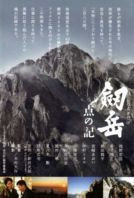A historical biopic about Japanese surveyors trying to map Mt. Tsurugi-dake (Sword Mountain) in 1907.
The
army uses triangulation of stone markers placed previously on other
points to continue with their work. When news that an amateur mountain
climbing club is planning to get to the top first, the army wants badly
to map the area and claim the mountain first. They bully and coerce their chosen man, Shibasaki
(Tadanobu Asano), pretty much giving him no chance to refuse this job, calling
him a coward if he won't attempt this and succeed to boot (and in Japanese culture
to lose face is a big thing). In 1906, he consults a retired surveyor
Furuta (Kôji Yakusho) who had previously tried climbing the mountain but
was unsuccessful.
Shibasaki hires Chojiro (Teruyuki Kagawa) as
his guide. Chojiro used to work with Furuta. (There is some unwritten
political rule that implies Chojiro shouldn't be doing this, and he gets
some heat for it, I couldn't tell what that was all about. Perhaps Furata has more seniority so it was considered disrespectufl for Chojiro to be consulted like this.)
Shibasaki
and Chojiro don't make it successfully in 1906, turned back eventually by bad
weather and impassability. They try again in 1907 with more men, and
more pressure, as the army heads and the climbing club are both breathing down
their backs.
Like the best underdog sports stories the men
eventually reach the top (with remarkably few injuries) but the film
recounts a bitter real life ending as something happens where the army
decides not to acknowledge their achievement. The film ends with a
listing of the many many people and organizations that have climbed
these mountains, acknowledging them as comrades.
Although
Shibasaki is the film's protagonist, it is Chojiro who is the film's
heart. He holds the mountains in reverence, and the bits about the
unwritten rule against him makes his participation more important and
personal. This film was made just a few years ago, but there is little I can find about it (or the historic climb) so I don't know much about the
book this was based on or the film itself.
During a Q&A, the emcee at this film
screening says that no CGI was used in the making of this film, which
is remarkable since you can tell the crew and actors were actually
climbing around there; there were swaths of untread snow where you could
see these were the only people there. And also how these men climbed
back then, in shoes made of straw, spikes tied on their shoes with rope,
carrying their own equipment, etc. seemed so rudimentary and archaic
compared to their daunting task. The film also uses the music of Vivaldi and Bach to
complement the visuals of mountain scenes and big weather events.
Hopefully the DVD will have a making of or a historical/factual retelling to explain more of this event.

No comments:
Post a Comment